Leytonstone House Hospital
742 High Road, E11 1HS
Medical dates:
Medical character:
Mental handicap
Built in the 18th century,
originally as the home of the Buxton brewing
family, Leytonstone House and its grounds were sold to the
Bethnal Green Poor Law Guardians for
£9,500 when the family moved to a new residence in Buckhurst Hill
in 1868. The Guardians established an industrial school on the 9
acre site -
the Bethnal Green Schools
for the Juvenile Poor - which opened the same year. Children
between the ages of 3 and 14 years who had been orphaned or deserted,
or whose parents were ill or in prison, were sent to the Schools.
Temporary iron buildings initially housed some 370 children, but
permanent brick semi-detached 'cottage homes' gradually replaced the
temporary structures.
In 1930 control of the Schools, now known as Leytonstone Children's Home, passed to the LCC. Children over 5 years of age attended the local community schools.
In 1936 the LCC announced that the Home was to close as its Mental Hospitals Committee needed more accommodation for mentally handicapped patients. The Home closed in late 1936 and re-opened in April 1937 as Leytonstone House Hospital, an annexe to Darenth Park Hospital in Dartford. Six villas had been adapted and the staff quarters enlarged, all for a cost of £48,600. Each of the villas had a downstairs day room, bathroom and WC, a small kitchen and a staff office. The two floors above contained 48 beds in dormitories and cubicles. The Hospital also had a large dining room, a swimming pool, and needlework and laundry areas. Selected female patients from Darenth Park and other hospitals were sent to Leytonstone House specifically to be trained for local employment. The patients did domestic chores as part of their training and also for the benefit of the running of the institution. Leytonstone House itself was used as offices for the administrative and medical staff.
By the end of WW2 the Hospital housed 220 female patients from all over England.
In 1948 it joined the NHS and became a branch of the South Ockendon Institution for Mental Defectives, under the control of the South Ockendon Hospital Management Committee. Patients moved between other branches of the Institution - Great West Hatch, Little West Hatch and Bramley House - as directed by the staff. Leytonstone House became the headquarters of the South Ockendon Hospital Management Committee and was also used as a base for the resident Medical Officer. By the end of the decade the main hall of the Hospital was used for recreation - dancing, games, badminton and drama, etc.
In 1950 Gardenia Ward was refurbished to house 40 'cot and chair cases', girls and boys under the age of 16 years. Other wards were altered as 'treatment' moved away from domestic training to physical care and support. Eight new sick beds were opened and Clover ward became a locked ward. In 1954 a school was opened in the needleroom.
Leytonstone House was listed as a Grade II building in 1954, and this also protected the adjacent Victorian school buildings.
In 1955 Vera Lynn visited and donated the first 'penny for the pot', beginning a fund for a holiday home for the patients. (The holiday home finally opened in 1970 at Dovercourt, Harwich.)
During the 1950s and 1960s the more able residents moved to hostel accommodation. They were replaced by patients with greater handicap. By 1964 there were 370 patients and the Hospital had become overcrowded.
In 1969 the wards were modernised and a new ward - Lister - opened. In 1970 the first male nurse was appointed and male patients admitted. To create a male ward the elderly female patients in E block were moved to the sick bay, B block (where they all died one by one). The boys arrived from South Ockendon Hospital but, by the next day, they had broken all the windows of their ward, broken their new beds and 'watered' the garden.
In May 1972 50 female patients were sent to South Ockendon Hospital in exchange for 50 male patients. The number of male patients increased gradually over the next few years and some wards were mixed. In 1974 Leytonstone House Hospital came under the control of the Redbridge and Waltham Forest Area Health Authority. A volunteers programme was established, bringing the local population more in contact with the patients. In 1976 Mencap enabled some patients to be rehoused in 'Outward Housing'. In 1977 two new wards - Livingstone and Matheson - opened, despite newspaper stories of the deteriorating state of the Hospital.
In August 1978, following accusations by residents of alleged theft of money by eight nurses, the nursing staff threatened to strike. New admissions ceased and the nurses refused to work overtime or to perform non-nursing duties. Life for the patients became heavily restricted and many were not able to leave their wards. The situation was finally resolved in June 1979 by a new management structure being put in place. One of its first actions was to spend £26,000 on new clothes for the patients.
The Jay Report published in 1979 emphasized new principles on the rights of the mentally handicapped. Nurses no longer wore uniforms, but were given an allowance towards their work clothes.
By this time the lack of nurses' accommodation had discouraged young adults from a nursing career, and many nurses were recruited from overseas to work in the NHS.
In 1980 the Department of Health instructed the Hospital that children under the age of 16 should not be admitted. Children resident at the Hospital were rehoused. In 1981 a Behavioural Therapy Unit opened in the previously closed C block. In the same year the Department of Health published 'Care in the Community' as a practical guide to aid patients towards independent living. In 1983 the Area Health Authority announced the phased closure of Leytonstone House Hospital. The 250 residents were relocated to their own boroughs or stayed in hostels in Waltham Forest, gradually building up the number of nights they spent away from the Hospital. The 'more complex needs' patients waited for new accommodation - Buxton Court - to be built.
In 1992 the Hospital, with 223 beds, transferred to the control of the Forest Health Trust. The wards were gradually vacated and the staff redeployed.
The Hospital finally closed in May 1994.
In 1930 control of the Schools, now known as Leytonstone Children's Home, passed to the LCC. Children over 5 years of age attended the local community schools.
In 1936 the LCC announced that the Home was to close as its Mental Hospitals Committee needed more accommodation for mentally handicapped patients. The Home closed in late 1936 and re-opened in April 1937 as Leytonstone House Hospital, an annexe to Darenth Park Hospital in Dartford. Six villas had been adapted and the staff quarters enlarged, all for a cost of £48,600. Each of the villas had a downstairs day room, bathroom and WC, a small kitchen and a staff office. The two floors above contained 48 beds in dormitories and cubicles. The Hospital also had a large dining room, a swimming pool, and needlework and laundry areas. Selected female patients from Darenth Park and other hospitals were sent to Leytonstone House specifically to be trained for local employment. The patients did domestic chores as part of their training and also for the benefit of the running of the institution. Leytonstone House itself was used as offices for the administrative and medical staff.
By the end of WW2 the Hospital housed 220 female patients from all over England.
In 1948 it joined the NHS and became a branch of the South Ockendon Institution for Mental Defectives, under the control of the South Ockendon Hospital Management Committee. Patients moved between other branches of the Institution - Great West Hatch, Little West Hatch and Bramley House - as directed by the staff. Leytonstone House became the headquarters of the South Ockendon Hospital Management Committee and was also used as a base for the resident Medical Officer. By the end of the decade the main hall of the Hospital was used for recreation - dancing, games, badminton and drama, etc.
In 1950 Gardenia Ward was refurbished to house 40 'cot and chair cases', girls and boys under the age of 16 years. Other wards were altered as 'treatment' moved away from domestic training to physical care and support. Eight new sick beds were opened and Clover ward became a locked ward. In 1954 a school was opened in the needleroom.
Leytonstone House was listed as a Grade II building in 1954, and this also protected the adjacent Victorian school buildings.
In 1955 Vera Lynn visited and donated the first 'penny for the pot', beginning a fund for a holiday home for the patients. (The holiday home finally opened in 1970 at Dovercourt, Harwich.)
During the 1950s and 1960s the more able residents moved to hostel accommodation. They were replaced by patients with greater handicap. By 1964 there were 370 patients and the Hospital had become overcrowded.
In 1969 the wards were modernised and a new ward - Lister - opened. In 1970 the first male nurse was appointed and male patients admitted. To create a male ward the elderly female patients in E block were moved to the sick bay, B block (where they all died one by one). The boys arrived from South Ockendon Hospital but, by the next day, they had broken all the windows of their ward, broken their new beds and 'watered' the garden.
In May 1972 50 female patients were sent to South Ockendon Hospital in exchange for 50 male patients. The number of male patients increased gradually over the next few years and some wards were mixed. In 1974 Leytonstone House Hospital came under the control of the Redbridge and Waltham Forest Area Health Authority. A volunteers programme was established, bringing the local population more in contact with the patients. In 1976 Mencap enabled some patients to be rehoused in 'Outward Housing'. In 1977 two new wards - Livingstone and Matheson - opened, despite newspaper stories of the deteriorating state of the Hospital.
In August 1978, following accusations by residents of alleged theft of money by eight nurses, the nursing staff threatened to strike. New admissions ceased and the nurses refused to work overtime or to perform non-nursing duties. Life for the patients became heavily restricted and many were not able to leave their wards. The situation was finally resolved in June 1979 by a new management structure being put in place. One of its first actions was to spend £26,000 on new clothes for the patients.
The Jay Report published in 1979 emphasized new principles on the rights of the mentally handicapped. Nurses no longer wore uniforms, but were given an allowance towards their work clothes.
By this time the lack of nurses' accommodation had discouraged young adults from a nursing career, and many nurses were recruited from overseas to work in the NHS.
In 1980 the Department of Health instructed the Hospital that children under the age of 16 should not be admitted. Children resident at the Hospital were rehoused. In 1981 a Behavioural Therapy Unit opened in the previously closed C block. In the same year the Department of Health published 'Care in the Community' as a practical guide to aid patients towards independent living. In 1983 the Area Health Authority announced the phased closure of Leytonstone House Hospital. The 250 residents were relocated to their own boroughs or stayed in hostels in Waltham Forest, gradually building up the number of nights they spent away from the Hospital. The 'more complex needs' patients waited for new accommodation - Buxton Court - to be built.
In 1992 the Hospital, with 223 beds, transferred to the control of the Forest Health Trust. The wards were gradually vacated and the staff redeployed.
The Hospital finally closed in May 1994.
Present status (January 2008)
In 1991 Tesco acquired the site containing Leytonstone House and the school buildings in order to build a major store.
Most of the site is now a Tesco superstore, but also contains a health centre and a small mixture of retail outlets, offices and homes.
The Grade II listed buildings remain. The small shopping parade leading over to the High Road was once the girls side of the old School buildings.
Mencap occupy one of the former staff accommodation blocks near the High Road.
In 1991 Tesco acquired the site containing Leytonstone House and the school buildings in order to build a major store.
Most of the site is now a Tesco superstore, but also contains a health centre and a small mixture of retail outlets, offices and homes.
The Grade II listed buildings remain. The small shopping parade leading over to the High Road was once the girls side of the old School buildings.
Mencap occupy one of the former staff accommodation blocks near the High Road.
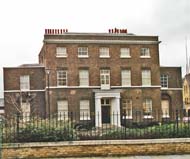
Leytonstone House, currently occupied by the chartered accountants, Barnes Roffe.

The shopping parade in the girls side of the Schools, as seen from the east entrance off the High Road.

Hospital-related plaques in the arcade along the shopping parade.
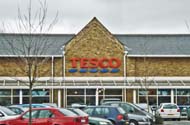
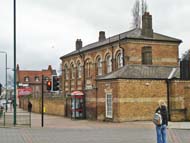
The old School reception block off the High Road.
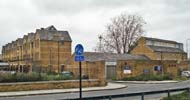
Former School buildings off the High Road - the boys side on the left and the workshops with a clerestory roof on the right.
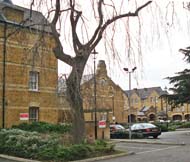
The former School buildings behind the shopping parade.
The Tesco superstore looks as though it was built from recovered bricks.
Chaplin R, Peters S 2003 Executives have taken over the asylum: the fate of 71 psychiatric hospitals. Psychiatric Bulletin 27, 227-229.
Smith T (ed) 2005 Life and Times at Leytonstone House. London, Waltham Forest Mencap.
http://edithsstreets.blogspot.co.uk
www.bestcarehome.co.uk
www.mcch.org.uk
www.schoolsofnursing.co.uk
Return to home page